| printer friendly | |||
|
|||
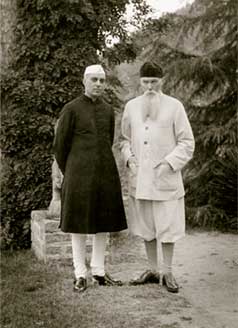 | |
| J. Nehru and N. Roerich. Kullu. 1942 |
On one of the photographs in the hall, there are N. Roerich and Jawaharlal Nehru. “It’s a week that Nehru with his daughter have been with us, Roerich wrote. – A wonderful, outstanding worker <…> We spoke about the Indian-Russian Cultural Association. It is time to think of useful, conscious cooperation”10. In 1942, in the most difficult days of the war, the Russian artist and the future Prime-Minister of India discussed the fate of the new world, in which Freedom and Culture will triumph, they dreamed of close collaboration of Russia and India.
“The heart of India is turning to spanless Russia, Nicholas Roerich wrote. – The great Indian magnet attracts the Russian hearts. Indeed, “Altai – Himalayas” – two magnets, two balances, two foundations. It makes you happy to see the viability of the Indian-Russian links.
It’s not the politics that matter, but live, warm-hearted human relations. Political seams are not strong, all the time they burst and reveal revolting rips. Another matter are strong cordial patterns. The more ancient, the more beautiful they are.
Beauty is laid in the Indian-Russian magnet. A heart sends a message to a heart”11.
After many years, Indira Gandhi, J. Nehru’s daughter, would say about the painter: “His wonderful paintings strike with richness and subtle sense of color, and, first of all, they wonderfully convey the mysterious magnificence of the nature of Himalayas. And he himself, in his looks and nature, seemed to have absorbed to a certain extent the soul of the great mountains. He did not speak much, but controlled power emanated from him, which seemed to fill all the space around… We also appreciate him as a connecting link between the Soviet Union and India”12.
 | |
| Bronze from the Roerich family collection |
He, same as Helena Roerich, did not have any social life <…> From early morning till late at night, their day was filled with useful work. In the daytime, there were meetings which made part of the orbit of my father’s public life; he also took his notes, in between, he listened to music – this refreshed him – and then continued his work until late at night”13.
In the hall show-case, there are a few music records from the family collection. They listened to music every day. They liked Wagner, Scriabin, often played Rimsky-Korsakov, Stravinsky, Grig. Here there are also Nicholas Roerich and his family’s personal belongings, preserved figures of Tibetan chess. In the central show-case, there is ancient bronze of Kullu from the Roerichs’ collection.
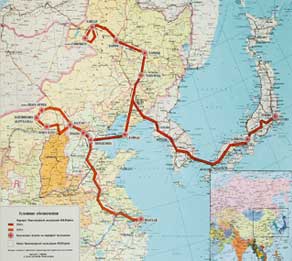 | |
| The map of the Manchurian expedition itinerary. 1934 – 1935 | |
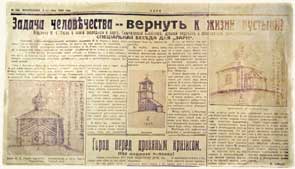 | |
| Cutting from the “Zarya” newspaper. September 9, 1934 |
In the valley of Kullu, they loved and respected all the Roerich family – for their kindness, sympathy, readiness to help. In the morning, local people often brought flowers for Helena and Nicholas Roerichs. On holidays, they showed up with touching gifts and danced happily at the villa gate. In the valley, they called the painter Rishi – wizard, or Maharishi – great wizard. They came to see his paintings. And stood still conquered by the beauty opened before them…
In Kullu, Roerich continued painting canvases dedicated to the Central-Asian expedition. As a thinker and painter, he was still moving along the Great Path of tireless wanderers and settlers. He dreamed of a new expedition to Asia.
New possibilities opened in the USA Agricultural Department. America suffered of erosion of soils. The Minister of Agriculture of the USA Henri Wallis suggested that N. Roerich organize study and collection of drought-resistant sorts of plants growing in Asian steppes and on the outskirts of deserts.
The map showing the itinerary of the expedition to Manchuria and China in 1934 – 1935 is exhibited in the hall.
Japan had already occupied Manchuria and part of Inner Mongolia, so the permit for entering these regions had to be obtained in Tokyo. In June 1934, Nicholas and George Roerich headed for the Barguin Plateau through Harbin. They searched for drought-resistant plants, performed archeological excavations, studied the beds of dried out rivers – and they came to the conclusion that deserts are not only created by nature, but are the result of human activities.
 | |
| N. Roerich during the Manchurian expedition. 1934 – 1935 | |
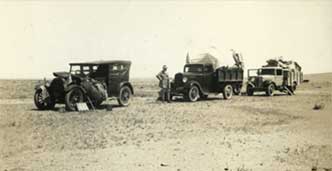 | |
| Manchurian expedition convoy. 1934 – 1935 |
“The task of humanity is to bring deserts back to life!” – under this title, the interview with N. Roerich appeared in the newspaper in 1934. The cutting from the newspaper is exhibited in the show-case.
Soon, the Japanese authorities sent the Roerichs out of the Barguin Plateau. They went to Harbin, and from there headed for Chine, which was not yet captured by the Japanese.
On the photographs in the show-cases, participants of the Manchuria expedition are captured. The first stop was made in Tsagan-Kur, near boundary sands of Gobi. Then the camp was moved to the Alashan desert outskirts.
“Time after lunch; the heat of 160 degrees by Fahrenheit, N. Grammatchikov, who was in charge of transport at the expedition, tells. – The whole camp <…> as if died, dried out because of this scorching heat. <…>
Nicholas Roerich works sitting on a folding chair, or under the tree, or in the yurt…
An awful wind is howling, it raises clouds of yellow sand, shifts, turns over the yurts, sometimes, mixed with the sand, snow starts falling. The cold penetrates into every chink. Muffled up, the expedition members sit trying to get warmer near the stove. Nicholas Roerich, to the wind howl, dictates an article about something lofty, beautiful, kind”15.
Troubles and calamities of the world penetrated into the desert too. The camp had to be secured at night, they needed weapons again. But the expedition also came to contact with a different life, in which legend and reality merged into one single whole.
“At night, all the star chambers are shining. All wonderful signs are gleaming. The Book of Majesty is opened. Behind the mountain, a ray of light flashed up. Who is there? Who passed there? Maybe, Erdeni Mori?”16 Again legends about the miraculous stone, the Sacred Country, the Mahatmas, sounded.
Roerich worked tirelessly and intensively. He conducted expedition researches, wrote essays, painted. He was not a botanic, but could unmistakably find the necessary plant. For a year, the expedition discovered about 300 species of drought-resistant herbs. About 2 thousand parcels of various seeds, herbs, and bushes were sent to the USA. Valuable ancient manuscripts were collected, archeological researches were performed.
In the Alashan desert, they discovered ruins of an ancient city. Once flourishing territory turned into a fruitless desert. “Such material cemeteries, the painter reflected with bitterness, – are the best evidence of what human rage can be like. And who will dare to state that the rage of the XII century was stronger than the rage contemporary to us? Rage is rage. Betrayal is betrayal. Wrath is wrath – beyond centuries and nations”17.
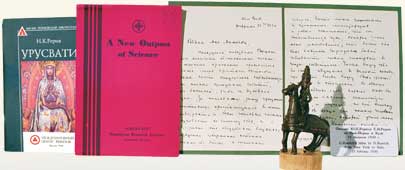 | |
| Show-case fragment |
Personal responsibility for peace for the whole world was undertaken by Nicholas Roerich. Was undertaken by all the Roerich family members.
|
|
||
|
||
